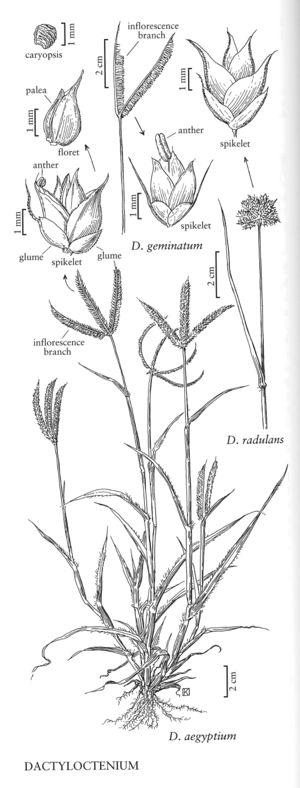Dactyloctenium
| Taxon | Illustrator ⠉ | |
|---|---|---|
 | Dactyloctenium aegyptium Dactyloctenium radulans Dactyloctenium geminatum | Karen Klitz Linda A. Vorobik Karen Klitz Linda A. Vorobik Karen Klitz Linda A. Vorobik |
Plants annual or perennial; tufted, stoloniferous, or rhizomatous. Culms 5-115 (160) cm, erect or decumbent, often rooting at the lower nodes, not branching above the base. Sheaths not over¬lapping, open, keeled; auricles absent; ligules membranous, membranous and ciliate, or of hairs; blades flat or involute. Inflorescences terminal, panicles of 2-11, digitately arranged spicate branches; branches with axes 0.8-11 cm long, extending beyond the spikelets, terminating in a point, the spikelets imbricate in 2 rows on the lower sides. Spikelets with 3-7 bisexual florets, additional sterile florets distally; disarticulation usually above the glumes, the florets falling as a unit. Glumes unequal, shorter than the adjacent lemmas, 1-veined, keeled; lower glumes acute, mucronate; upper glumes subapically awned, awns curved; calluses glabrous; lemmas membranous, glabrous, 3-veined (lateral-veins sometimes indistinct), strongly keeled, apices entire, mucronate, or awned; paleas glabrous; anthers 3, yellow; ovaries glabrous; styles fused. Fruit utricles; seeds falling free of the hyaline pericarp, transversely rugose or granular, x = 10.
Distribution
Pacific Islands (Hawaii), Fla., N.J., N.Mex., Tex., La., Tenn., N.C., S.C., Pa., Ariz., Mass., N.Y., Va., Colo., Calif., Puerto Rico, Virgin Islands, Ala., Ark., Ill., Ga., Maine, Md., Ohio, Miss.
Discussion
Dactyloctenium is primarily an African and Australian genus of 10-13 species. Three species have been introduced in the Flora region, two of which have become established. Dactyloctenium aegyptium is widespread throughout the warmer areas of the world.
Selected References
Key
| 1 | Panicle branches 0.4-1.5 cm long; most spikelets touching those of an adjacent branch | Dactyloctenium radulans |
| 1 | Panicle branches 1.5-7 cm long; only the first few proximal spikelets on each branch in contact with those on an adjacent branch. | > 2 |
| 2 | Anthers 0.5-0.9 mm long; upper glume awns 1-2.5 mm long | Dactyloctenium aegyptium |
| 2 | Anthers 1.1-1.7 mm long; upper glume awns 4.5-10 mm long | Dactyloctenium geminatum |
"decumbent" is not a number.